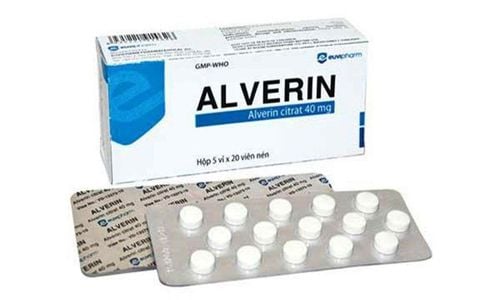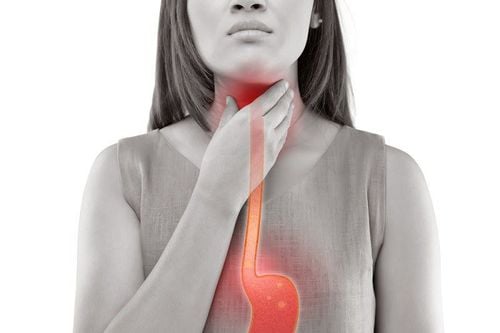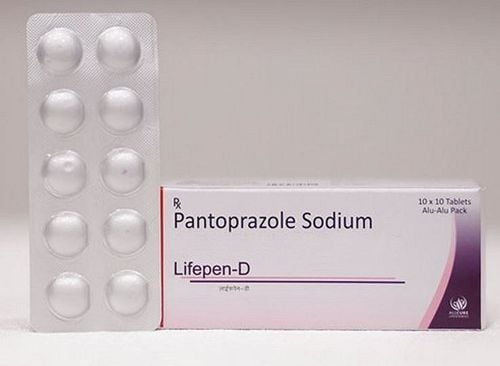This is an automatically translated article.
Posted by Master, Doctor Mai Vien Phuong - Department of Examination & Internal Medicine - Vinmec Central Park International General Hospital
Patients with tooth decay, long-lasting mouth ulcers, went to many places, met many otolaryngologists, otolaryngologists but still did not reduce the disease. It was time to see a gastroenterologist, found that the patient had reflux esophagitis, and the doctor concluded that the patient's condition was caused by reflux esophagitis. What are the characteristics of this disease? Why can reflux esophagitis cause long-term oral pathologies? This article will address that issue.
1. Overview of Reflux esophagitis (also known as Gastroesophageal Reflux)
Gastroesophageal reflux disease (GERD) is a common gastrointestinal (GI) disease with worldwide prevalence and high prevalence in Western countries. The 2006 Montreal Consensus defined gastroesophageal reflux disease as a condition that develops when the reflux of gastric contents causes troublesome symptoms and/or complications into the esophagus. Tissue damage associated with gastroesophageal reflux disease ranges from esophagitis to Barrett's esophagus and adenocarcinoma of the esophagus; The troubling symptoms of reflux can be esophageal (regurgitation, regurgitation) or extraesophageal. Gastroesophageal reflux disease can be further classified by the presence of an erosive stain on endoscopic examination (Erosive Reflux Disease [ERD] and Non-Erosive Reflux Disease [NERD].
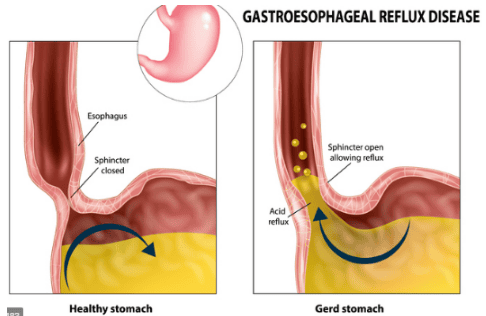
Extraesophageal manifestations associated with gastroesophageal reflux disease are frequent and represent a diagnostic and therapeutic challenge, possibly involving the lungs, upper respiratory tract, and mouth, presenting with asthma, laryngitis, chronic cough, tooth wear and non-cardiac chest pain
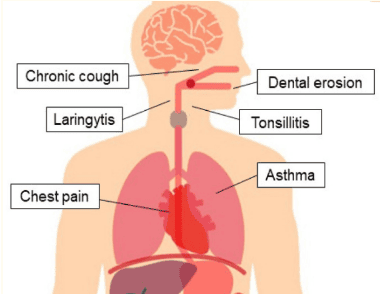
2. Pathology of the oral cavity due to gastroesophageal reflux
2.1 Oral cavity
Saliva is the main defense mechanism from exposure to acids present in the oral cavity: the quality and quantity of saliva provides protection through acid clearance and neutralization. Saliva secretion varies throughout the day, depending on circadian rhythms and food stimuli: a salivary flow rate of 0.2 mL/min (milliliters per minute) is the lower limit of total saliva. is normally unstimulated, while 0.7 mL/min is the lower limit of stimulated salivary flow.
Saliva function involves the removal of pathogenic bacteria that can destroy tissues and cause tooth decay in conditions of poor oral hygiene. The presence of lysozyme, lactoferrin, thiocyanate ions and antibodies make saliva an excellent antibacterial agent, while its neutral pH protects the inorganic matter of the teeth.
Saliva flow and swallowing function are significantly reduced in patients with GERD. A decrease in saliva production leads to dry mouth, sometimes progressing to dry mouth disease. Gingivitis, defined as periodontal soft tissue inflammation, can result from decreased salivation. Coexistence of bruxism can exacerbate periodontal disease.
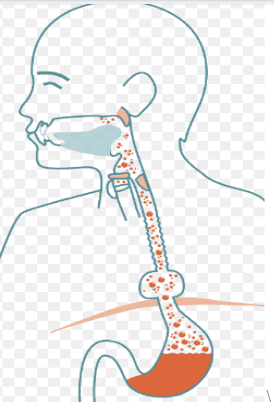
2.2 Corrosion of teeth
Tooth erosion is irreversible loss of tooth hard tissue by a chemical process unrelated to bacteria and it is a major known oral symptom of acid reflux in patients with GERD. Esophageal thickening, according to the Montreal Definition and Classification. The mean prevalence of dental erosion in patients with gastroesophageal reflux disease ranged widely, from 5% to 47.5%, with a higher severity than in healthy subjects.
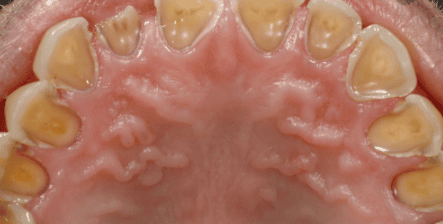
Causes of erosive dental disease
Tooth erosion is caused by a combination of extrinsic factors, such as demineralized acidic foods, acidic beverages and drugs, and internal causes cause tooth wear, such as persistent vomiting or acid reflux. Hydroxyapatite crystals, the main component of tooth enamel, will be damaged if exposed to a pH lower than 5.5.
Reflux agents usually have a pH lower than 2.0, potentially eroding tooth tissues, depending on the duration and number of reflux episodes and the function of protective factors such as saliva. Although both tooth erosion and caries determine the loss of tooth mineral composition, the former occurs on plaque-free surfaces, whereas caries depends on acid exposure. weak from dental plaque. While tooth erosion can be caused by acid reflux, tooth decay does not appear to be related to GERD.
Dental Erosion Disease Classification
Dental erosion is classified based on the amount and severity of erosion: grade 0 (no erosion), grade 1 (loss of enamel-like cream-like appearance) , grade 2 (loss of enamel surface features: smooth matte surface, no dentin contact), grade 3 (involving enamel and dentin), and grade 4 (involving severe structure with tooth destruction).
Tooth erosion caused by gastroesophageal reflux disease can involve any surface of the tooth, although it is more common on the tooth surface (jaw), bite and language: Acid Reflux Attacks the palatal surface of the upper teeth first and then, if this continues, other teeth may be affected.
In children with gastroesophageal reflux disease, the primary teeth are affected more than the permanent teeth, are less mineralized and thinner; therefore, they are more susceptible to acid corrosion.
Due to the high prevalence of dental erosion in patients with gastroesophageal reflux disease, cooperation between dentists and gastroenterologists should be promoted. Subjects with unexplained tooth erosion should be referred to the gastroenterology department to investigate the presence of undiagnosed gastroesophageal reflux disease.
2.3 Oral soft tissue disorders
Oral soft tissue can also be damaged by gastroesophageal reflux disease. Associations with gastroesophageal reflux disease have been suggested for tonsillitis, mucosal atrophy, congestion in the soft palate and uvula, glossitis, epithelium atrophy, lacrimal sac inflammation, and developmental disorders. Common oral complaints in patients with GERD are dry mouth, sour and sour taste, bad breath, itching and burning, and throat discomfort.
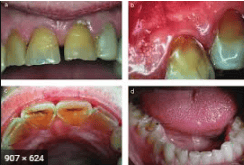
Gastroesophageal reflux disease can cause damage to the oral mucosa, although mucosal changes are not pathognomonic of gastroesophageal reflux disease: Oral candidiasis, Sjögren's syndrome, dysuria Drug-related diabetes mellitus, poor oral hygiene, dietary changes, and smoking-related oral lesions also present similar manifestations. The Palatal regions are often destructive by gastroesophageal reflux disease.
Although mucosal lesions have been found in patients with reflux disease, the literature does not demonstrate a difference between GERD patients and healthy controls in terms of dental lesions. chu. Because of their nonspecificity, oral soft tissue disorders are not considered an extraesophageal manifestation associated with gastroesophageal reflux disease according to the 2006 Montreal consensus.
3. Diagnosis of oral disease caused by gastroesophageal reflux disease
Early diagnosis and prevention of acid reflux through lifestyle changes and medication have been reported to prevent damage to the soft and hard tissues of the oral cavity.
This diagnosis is usually made by examining the oral cavity by a dentist or oral hygienist. Evaluation of the oropharynx and larynx for signs of gastroesophageal reflux disease can help the clinician in the diagnosis and subsequent treatment of the patient. Since dental erosion is the predominant oral manifestation of GERD, dental examination plays an important role in the early diagnosis of GERD in asymptomatic patients. The association with typical or atypical reflux symptoms supports the suspicion of underlying gastroesophageal reflux disease.
Due to the low sensitivity of diagnostic tests such as endoscopy and pH monitoring, and the low specificity of laryngoscopy, response to acid suppression therapy is now considered the first diagnostic step in The patient is suspected of having oral symptoms related to gastroesophageal reflux disease.
4. Treatment of oral diseases caused by gastroesophageal reflux disease
In patients with dental erosion, prevention and treatment strategies are important. Recommended strategies to prevent progression of this condition include taking an antacid immediately after heartburn or feeling acid reflux in the oropharynx, rinsing with a medium pH mouthwash. neutral or sodium fluoride, avoid brushing immediately after reflux episodes, apply fluoride gel immediately after reflux, avoid using conditioners, lubricate the oral cavity with a saliva substitute, or stimulate secretions saliva with sugar-free gum.
Dietary changes are also recommended, such as avoiding highly processed acidic foods, rich in fats and added sugars (sour candies, spicy, salty snacks, carbonated drinks, fortified water) energy and sports), while fresh and minimally processed acidic foods (fresh fruits, tomatoes and savory vegetables) can be included in mixed meals. Behavioral changes include smoking cessation and good oral hygiene.
5. The role of antisecretory drugs PPI
Current guidelines recommend empiric therapy with twice-daily PPIs in patients with oral manifestations suspected of being associated with gastroesophageal reflux disease. There are no studies on the effect of anti-reflux surgical therapy on dental erosion associated with gastroesophageal reflux disease. In patients with laryngopharyngeal reflux unresponsive to appropriate PPI therapy, studies have shown that surgical treatment does not lead to further improvement in laryngeal outcome or pharyngeal symptoms. Therefore, fundraising surgery is not recommended in this setting, while it may be considered second-line therapy in patients who respond to PPIs but relapse after discontinuation.
Conclusion
The diagnosis of extraesophageal manifestations associated with gastroesophageal reflux disease is not simple and is usually excluded. Esophagogastroduodenoscopy plays a secondary role, more useful if alarming symptoms are present. 24 h esophageal pH monitoring is relevant in the diagnosis of extraesophageal manifestations. This test allows the diagnosis of acid reflux events in the esophagus and, using pH impedance monitoring, the reflux of both acidic and non-acidic materials into the esophagus can also be identified. The PPI test is often used as the first diagnostic step. In atypical cases, diagnostic tools such as laryngoscopy and bronchoscopy may be useful to detect abnormalities associated with reflux lesions.
Currently, Vinmec International General Hospital is a prestigious address trusted by many patients in performing diagnostic techniques for digestive diseases, diseases that cause chronic diarrhea, Crohn's disease, gastric mucosa Esophageal ectopic... Along with that, at Vinmec Hospital, screening for gastric cancer and gastric polyps is done through gastroscopy with Olympus CV 190 endoscope, with NBI (Narrow) function. Banding Imaging - endoscopy with narrow light frequency) results in clearer images of mucosal pathology than conventional endoscopy, detecting ulcerative colitis lesions, digestive cancer lesions Early stage...
Vinmec Hospital with modern facilities and equipment and a team of experienced experts, always dedicated to medical examination and treatment, customers can rest assured with internal services. gastroscopy, esophagoscopy at Vinmec International General Hospital.
Please dial HOTLINE for more information or register for an appointment HERE. Download MyVinmec app to make appointments faster and to manage your bookings easily.
References1. Marilena Durazzo,1,2,* Giulia Lupi, Extra-Esophageal Presentation of Gastroesophageal Reflux Disease: 2020 Update, J Clin Med. 2020 Aug; 9(8): 2559.
2. Vakil N., Van Zanten S.V., Kahrilas P., Dent J., Jones R., Global Consensus Group The Montreal definition and classification of gastroesophageal reflux disease: A global evidence-based consensus. Am. J. Gastroenterol. 2006;101:1900-1920. doi: 10.1111/j.1572-0241.2006.00630.x. [PubMed] [CrossRef] [Google Scholar]
3. Kahrilas P.J., Altman K.W., Chang A.B., Field S.K., Harding S.M., Lane A.P., Lim K., McGarvey L., Smith J., Irwin R.S., et al. Chronic cough due to gastroesophageal reflux in adults: CHEST guideline and expert panel report. Chest. 2016;150:1341–1360. doi: 10.1016/j.chest.2016.08.1458. [PMC free article] [PubMed] [CrossRef] [Google Scholar]





